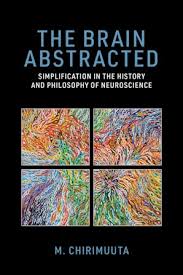Post 4 of 5 from Mazviita Chirimuuta on The Brain Abstracted (Open Access: MIT Press).
A central claim of the book is that recognition of the challenge of brain complexity — how it places pressure on scientists to devise experimental methods, theories and models, which drastically cut down the apparent complexity of neural processes – is indispensable when evaluating the philosophical import of neuroscientific results, and more generally, in understanding the historical trajectory of research on the brain. At risk of performative contradiction, the sole interpretative lens of abstraction is held up against neuroscience past and present with the aim of revealing the inner logic of certain puzzling features of neuroscientific discourse.
On the face of it, the topic of neural representation has little to do with the topic of simplification in science. Most philosophical work on neural representations tries to determine the legitimacy of neuroscientists’ talk of certain neural activations representing either states in the world or intentions for action. In short, the question is whether there are such things as neural representations, properly speaking. In Chapter 6 (Why “Neural Representations”?) my questions is, what are the epistemic benefits for neuroscientists in their use of intentional descriptions?, leaving the metaphysical question of the existence of neural representations on hold. I show that representation talk can be understood as a simplifying strategy which provides researchers with the means for focussing on the causal dependencies most relevant to explanation in cognitive neuroscience.
The brain is an extremely densely connected causal network. Asking for the causal explanation for any particular neural activation means asking what its cause was. This brings to light countless possibilities: the depolarisations induced by upstream neurons, the causes of their activations in turn, the mechanisms of action potential generation within the cell, the transduction of a sensory signal at a sensory organ, or the distal cause of that proximal sensory signal. All of these could potentially explain the firing of a neuron in primary visual cortex. That said, in cognitive neuroscience the overarching aim is to explain how it is that brain activity makes possible intelligent action in a wider world. Understanding how perception and motor control adaptively link the cogniser to their surroundings is key to this project. It becomes clear that for cognitive neuroscience the most explanatorily relevant cause of a sensory neural activation is the distal stimulus generated by the behaviourally relevant object in the environment, and not any of the intermediary neurophysiological causes that mediate between the distal stimulus and the final activation.
In sensory neuroscience, researchers typically talk of a V1 neuron representing an edge, a neuron in fusiform area representing a face, etc. Famously, this has been criticised by Ramsey (2007, Representation Reconsidered) as a misuse of the term representation since it does not meet the usual criteria such as determinacy of content. However, I argue that without talk of sensory activations as being representations of external objects, cognitive neuroscientists would lack a convenient way to legitimate their exclusive focus on distal causes at the expense of causal intermediaries. A parallel with Ernst Mayr’s distinction between proximate and ultimate causal explanation helps to illustrate why this is so. Mayr pointed out that an event demanding biological explanation, such as a warbler taking flight for migration on a certain day, can be explained in mechanistic terms that refer only to the immediate causal triggers within the bird, such as changes in hormone levels. But this reference to proximate causes is insufficient to explain the evolutionary factors that gave rise to this behaviour. For that we need the ultimate causal explanation, one that leapfrogs over all the details of anatomical and physiological changes induced by natural selection and focuses the researcher on the environmental factor that adaptively explains why a trait should exist, such as the availability of food at the destination of the migrating birds. In evolutionary biology, this pattern of explanation is legitimated by the presence of an evolutionary imperative that demands each species stand in a relationship with environmental factors that makes survival and reproduction possible. Similarly, in cognitive neuroscience, it is presupposed that neural activations stand in relationships with external states that facilitate adaptive, intelligent behaviour, and these relationships are intuitively conveyed with intentional but not mechanistic notions. When it is said that a picture (or a neural firing) represents a certain face, the causal chain between the face and the representation is irrelevant to the claim, and may not even exist, since it is possible to represent non-existent faces. For this reason, the positing of neural representations abstracts away from the causal chain mediating the distal object and the firing it elicits, hence it is a simplifying strategy.

